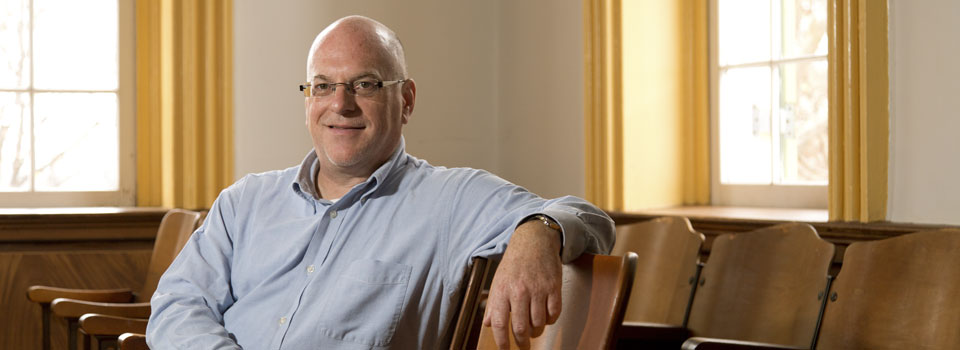Wayde Brown, an associate professor in the College of Environment and Design and assistant dean of research, says that historic preservation ultimately is about people rather than places.
Where did you earn degrees and what are your current responsibilities at UGA?
I received a professional degree in architecture from Dalhousie University in Canada, a master’s degree in architectural conservation from the University of York in the United Kingdom and a Ph.D. from the Welsh School of Architecture at Cardiff University.
I am an associate professor in the College of Environment and Design, teaching primarily in the historic preservation program, and just this year took on the additional role of assistant dean of research.
When did you come to UGA and what brought you here?
I came to UGA in 2002. While a major reason was the opportunity to become part of a long-established and well-respected program, I also came with a sense of adventure. I was previously living in Nova Scotia, Canada, and Athens, Ga., sounded quite exotic. Living here for over a decade, however, I have become more aware of the things that Georgia and Nova Scotia have in common, especially the relationship people have to the landscape, and to the history of “the place.”
What are your favorite courses and why?
I have had the opportunity to develop several new courses during my time at UGA, and these are the most enjoyable to teach. While my favorite may vary from year to year, I always look forward to “Interpretation of Historic Sites,” which is really about discovering the many stories that a historic site holds (and the most provocative stories are often deeply buried), and then telling those stories. Sometimes the stories are happy, but the most important ones are often difficult and in conflict. An aspect of this course I especially like is taking field trips with students; this term we have visited sites ranging from New Echota (the Cherokee capital) and the Etowah Indian Mounds to Chickamauga Battlefield and Liberty Hall, home of A.H. Stephens, the vice president of the Confederacy.
I also have enjoyed teaching a First-Year Odyssey seminar, both last year and this year. Entitled “Stories Beneath the Bricks,” it encourages students to approach historic buildings as “texts,” representing social and cultural history. During the course, we visit several buildings on the UGA campus in an effort to better understand the history of this institution.
What interests you about your field?
Historic preservation is ultimately about people rather than places. The buildings, monuments and landscapes that individuals, communities and nations elect to keep and celebrate are a reflection of our values, hopes and, sometimes, our fears. Historic preservation provides an opportunity to better understand people.
What are some highlights of your career at UGA?
While I can’t think of any particular events, I am always proud to represent UGA at meetings and conferences, especially abroad. I’ve been fortunate in my time here to present my research in several countries–Canada, Britain, Australia and, last year, Sweden.
How does your research or scholarship inspire your teaching, and vice versa?
I think that my teaching is inspired by my research less from any specific topic or project that my research entails, but more from the energy and enthusiasm that emerges when one is engaged in research activity; I share with my students, both formally and casually, the research questions I am grappling with, and hopefully inspire by example.
My research, in turn, is inspired by several aspects of teaching; for example, when the student asks the “too obvious” question that becomes “too difficult” to answer, you are reminded of why research—defining the question, seeking the answer—is wonderfully simple in concept, yet able to provoke the strongest passion in the curious researcher.
What do you hope students gain from their classroom experience with you?
Two things, which are in fact connected: a more sharply honed critical faculty and an increased sense of curiosity about the many wonders of the world.
Describe your ideal student.
The ideal student questions the ideas I present, generously shares their ideas with classmates—and arrives on time.
Favorite place to be/thing to do on campus is …
The Founders Memorial Garden, especially its more “remote” edges, is my favorite place; the color, the scents and the sounds all make a true “secret garden”—one with restorative powers!
Beyond the UGA campus, I like to…
Travel not just far afield, but also day and weekend trips within Georgia.
Community/civic involvement includes….
I am currently on the board of trustees of the Cherokee Garden Library, which is part of the Atlanta History Center and serves as an educational resource center for those interested in gardening, landscape design, garden history, horticulture, floral design, botanical art and ecology.
Favorite book/movie?
I have an eclectic mix of favorite books–from Isherwood’s “A Single Man” to Wells’ “The Time Machine,” which I first read as a comic book adaptation when I was a child. I also like to read poetry occasionally, especially Auden and Elizabeth Bishop. One of my favorite movies is “Cat on a Hot Tin Roof,” with Paul Newman and Elizabeth Taylor; it was released the year I was born.
Proudest moment at UGA?
I am always proud at graduation when I see another cohort of students preparing to start their professional lives and know that I will be at least a small part of that journey.
